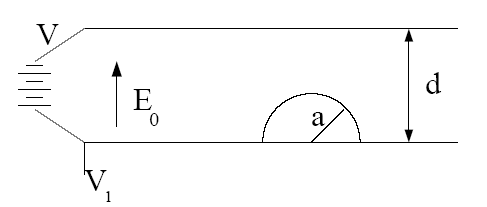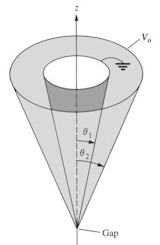More Problems
Problem 1:
A capacitor composed of two parallel infinite conducting sheets separated by a distance d is connected to a battery. The lower plate is maintained at some potential V1 and the upper plate is maintained at some potential V. A small hemispherical boss of radius a << d is introduced on the lower plate. State the boundary conditions for this problem. (Hint: Consider the limit as the distance between the plates becomes very large.) Find the potential between the plates and the surface charge density on the plates.

Solution:
- Concepts:
Boundary value problems, azimuthal symmetry. - Reasoning:
Put the origin of the coordinate system at the center of a sphere, the upper half of which is the hemispherical boss. Let the z-axis point up.
Then Φ(r,θ) = ∑n=0∞[Anrn + Bn/rn+1]Pn(cosθ) is the most general solution in the region between the plates, since the charge density ρ = 0 there. To find the specific solution we apply boundary conditions. - Details of the calculation:
The boundary conditions are Φ = V1 on the lower plate and the boss and Φ = V on the upper plate.
Φ = V1 + A1'rcosθ + (B1'/r2)cosθ between the plates outside the boss.
We assume all other coefficients are zero. If we find a solution with this assumption, it is the only solution.
Boundary conditions:
(i) Φ is continuous at r = a. 0 = A1'a + B1'/a2. B1' = -A1'a3.
(ii) E = -∇Φ = E0 at r >> a, i.e. far away from the hemispherical boss.
-A1'cosθ = E0cosθ, A1'sinθ = -E0sinθ, A1' = -E0, B1' = E0a3. E0 = (V - V1)/d.
Therefore
Φ = V1 - E0rcosθ + (E0a3/r2)cosθ.
Er = E0cosθ + 2(E0a3/r3)cosθ, Eθ = -E0sinθ + (E0a3/r3)sinθ.
E = E0 + 2(E0a3/r3)cosθ (r/r) + (E0a3/r3)sinθ (θ/θ).
E = external field + field due to polarized sphere.
Surface charge on the plates: σ = ε0E·n.
E·n = -E0 on the upper plate, σ = -ε0E0.
E·n = -Eθ = E0 - (E0a3/r3) on the flat part of the lower plate, σ = ε0E0 - ε0(E0a3/r3).
E·n = Er = 3E0cosθ on the boss, σ = ε03E0cosθ.
Problem 2
A charge q is located in the empty space above an infinite, flat,
grounded conducting plate whose surface coincides with the plane at z = 0.
The coordinates of the charge are (x, y, z) = (0, 0, d) with d > 0.
(a) Calculate the force acting on the charge.
(b) Calculate the electric field in the half-space z > 0.
(c) What is the surface charge density induced on the surface of the plate?
(d) How much work would be needed to pull the charge q away to z = +∞ along
the z-axis?
Solution:
- Concepts:
The method of images - Reasoning:
This problem involves a point charge in front of a conducting plane. The method of images yields the potential energy of the point charge and the force on the point charge. - Details of the calculation:
If the charge is a distance d from the conducting plane, it is a distance 2d from its image.
(a) The force on the charge is Fz = -q2/(16πε0d2).
(b) E(x,y,z) = [q/(4πε0)](xi + yj + (z - d)k)/(x2 + y2 + (z - d)2)3/2
- [q/(4πε0)](xi + yj + (z + d)k)/(x2 + y2 + (z + d)2)3/2.
(c) E(x,y,0) = [q/(4πε0)](xi + yj - dk)/(x2 + y2 + d2)3/2
- [q/(4πε0)](xi + yj + dk)/(x2 + y2 + d)3/2.
E(x,y,0) = -[qdk/(2πε0)]/(x2 + y2 + d2)3/2.
Surface charge density σ(x,y) = ε0E(x,y,0)·n = -[qd/(2π)]/(x2 + y2 + d2)3/2.
σ(ρ) = -[qd/(2π)]/(ρ2 + d2)3/2.
(d) The potential energy of the point charge (the negative of the work necessary to remove the charge from its position to infinity) is U = -q2/(16πε0d).
W = q2/(16πε0)∫d∞dz/z2 = q2/(16πε0d) is the work needed to pull the charge q away to z = +∞.
Problem 3:
 Two conducting cones (0 < θ1
< θ2 < π/2) of infinite extend are separated by an
infinitesimal gap at r = 0.
Let V(θ1) = 0 and V(θ2) = V0. Find V
between the cones.
Two conducting cones (0 < θ1
< θ2 < π/2) of infinite extend are separated by an
infinitesimal gap at r = 0.
Let V(θ1) = 0 and V(θ2) = V0. Find V
between the cones.
Laplacian in spherical coordinates:

∫dx/sinx = ln(tan(x/2))
Solution:
- Concepts:
Laplace's equation in spherical coordinates - Reasoning:
Since the cones are infinite, V can only depend on θ.
(Rotational symmetry --> no φ dependence
System is unchanged if we change the scale --> no r dependence)
∇2V = 0 becomes
(1/(r2sinθ))∂/∂θ(sinθ ∂V/∂θ) = 0.
Since r = 0 is excluded due to the insulating gap, we can write ∂/∂θ(sinθ ∂V/∂θ) = 0. - Details of the calculation:
Integrating once gives sinθ ∂V/∂θ = A, or ∂V/∂θ = A/sinθ.
Integrating again gives V = A ln(tan(θ/2)) + B.
Boundary conditions:
V(θ1) = 0 --> B = -A ln(tan(θ1/2)).
V(θ2) = V0 --> A ln(tan(θ2/2)) - A ln(tan(θ1/2)) = A ln[tan(θ2/2)/tan(θ1/2)] = V0.
A = V0/ln[tan(θ2/2)/tan(θ1/2)].
V(θ) = A ln[tan(θ/2)/tan(θ1/2)] = V0 ln[tan(θ/2)/tan(θ1/2)]/ln[tan(θ2/2)/tan(θ1/2)].